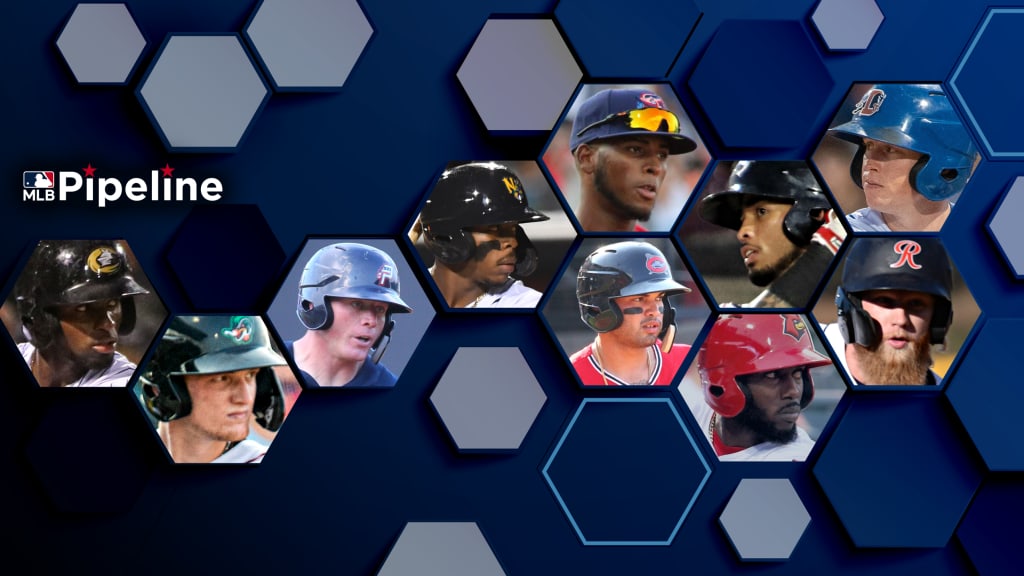
Perhaps no prospect rebounded more in 2019 than Trent Grisham.
Grisham, Milwaukee’s first-round pick in the 2015 Draft, batted .241 with 19 home runs in 1,488 plate appearances across his first four pro seasons before finally putting it together last season, slashing .300/.407/.603 with 26 homers in 441 plate appearances between Double-A and Triple-A. His Major League debut followed, and Grisham ultimately produced a .738 OPS with six home runs for the Brewers down the stretch before joining the Padres in a trade the day before Thanksgiving.
An improved contact point fueled Grisham’s turnaround, as he went from a hitter who let the ball travel too deep in the zone and therefore struggled to turn on the ball, to one who consistently achieved an ideal, more out-in-front point of contact and hit for power from line to line.
Using our Prospect Stats tool, we can see that Grisham’s batted-ball profile was markedly better in 2019. Specifically, after generating either a fly ball or line drive on 46.1 percent of his balls in play from 2015-18, the 23-year-old’s FB+LD rate jumped up to 56.5 percent last season in the upper Minors, and then held steady at 55.9 percent in his first taste of the big leagues.
While Grisham’s success reinforces the notion that player development does not occur linearly, it also speaks to how a player, regardless of age, can be an adjustment away from putting it all together.
With that said, here’s a stats-driven look at 10 hitters who got back on track in 2019:
Luis Robert, OF (White Sox No. 1/MLB No. 3): Signed by the White Sox for $26 million in May 2017, Robert battled a myriad of injuries during his first two pro seasons and failed to jump the yard in 50 games in 2018. Despite his struggles, it was only a matter of time until Robert, with his elite athleticism, immense physical strength and five-tool profile, figured it all out. That’s precisely what transpired in 2019, as the 22-year-old erupted to slash .328/.376/.624 with 32 homers (74 XBH) and 36 steals while climbing from Class A Advanced Winston-Salem to Triple-A Charlotte.
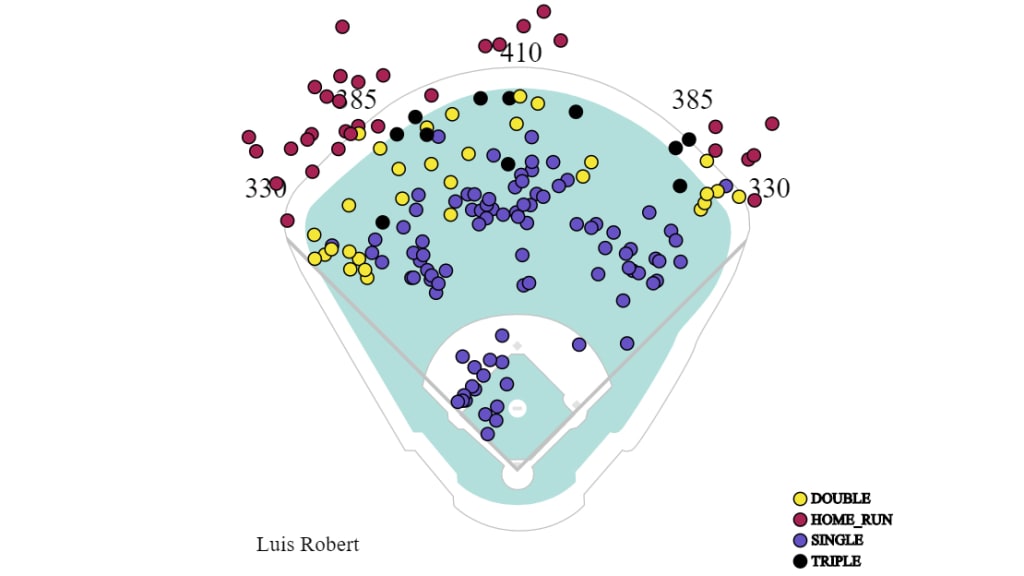
A closer look reveals the expected corresponding improvement in Robert’s batted-ball data, as he went from producing a fly ball or line drive on 46.5 percent of his balls in play (BIP) in 2018 to 57.9 in ‘19. And after previously demonstrating a tendency to lunge at pitches with a pull-happy approach, Robert has learned to keep his weight back and drive the ball to the other field, all while showing aptitude for recognizing and hitting secondary pitches.
The difference in Robert’s batted-ball data from 2018 to '19 when behind in the count is staggering: after generating a FB+LD on 10.9 percent of BIP in ’18, Robert did so at a 20.5 percent clip last season. He also recorded a 19.7 percent FB+LD rate in two-strike counts, up from 11.7 percent in ’18.
Sam Huff, C (Rangers No. 2/MLB No. 73): Huff, a seventh-round pick in 2016, put himself on the map last year as he posted an .845 OPS and swatted a career-high 28 homers while advancing from Class A Hickory to Class A Advanced Down East. The 21-year-old backstop showcased his power in the SiriusXM All-Star Futures Game with a booming two-run home run that ultimately netted him the game’s MVP award. Surprisingly, Huff’s 52.6 percent FB+LD rate last year actually was down from his first full season (55.2). He did, however, improve the quality of his contact, as 29.4 percent of his FB+LDs resulted in hits (up two percent from ’18). He also recorded a 15.5 percent extra-base-hit rate on FB+LD contact that was a slight improvement over his previous year’s mark (14.8 percent).
Jakson Reetz, C (Nationals): Reetz batted just .233 and showed very little pop during his first five seasons, posting an eight percent extra-base-hit rate on FB+LD contact while averaging one home run every 68.3 at-bats. The 23-year-old catcher’s struggles continued into the first half of the 2019, resulting in a .220 average and a 41.2 percent FB+LD rate that was below his 2014-18 average (42 percent). In the second half, however, Reetz was arguably the Carolina League’s most productive hitter, batting .282 with 12 home runs over his final 50 games. The 2014 third-rounder’s FB+LD rate jumped to 54.9 percent in that stretch, with 17.5 percent of said contact resulting in an extra-base hit, and he averaged a home run every 14.5 at-bats.
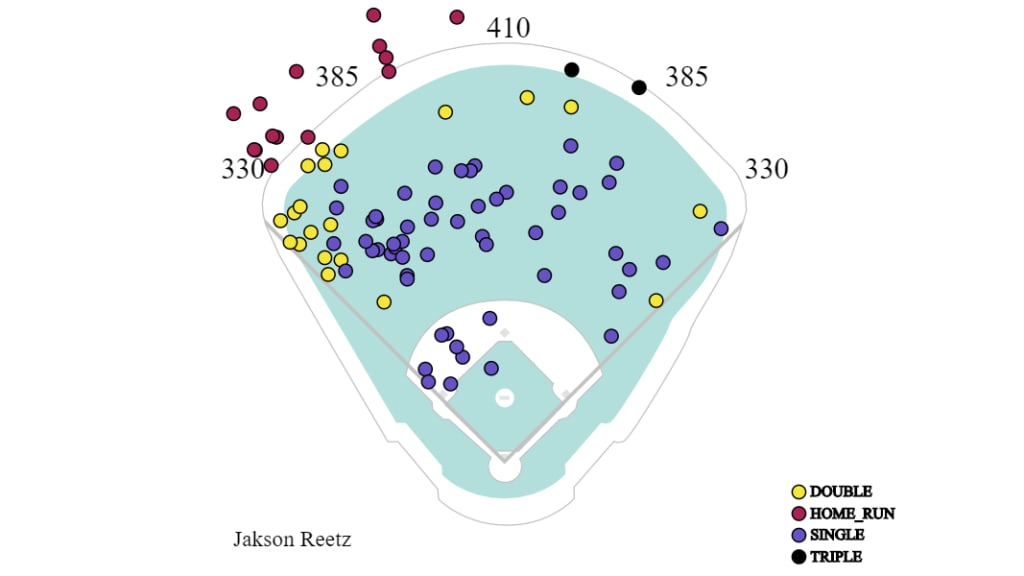
Monte Harrison, OF (Marlins No. 5): Harrison followed up his breakout campaign with a forgettable 2018 season in Double-A in which he batted just .240 with a Minor League-leading 215 strikeouts (36.9 percent strikeout rate). He retooled his swing that offseason, taming his once-pronounced leg kick with the goal of making more contact and whiffing less, and subsequently made across-the-board gains at Triple-A in 2019, albeit while battling injuries. Specifically, the 24-year-old trimmed his strikeout rate to 29.5 percent and walked at a 10 percent clip (up from 7.6 percent in ’18) en route to a .270 batting average and 74 strikeouts in 58 games.

Lewin Diaz, 1B (Marlins No. 12): Diaz quickly put his rocky 2018 Florida State League campaign (.224/.255/.344, 6 HR) behind him last season in his return to the level and had already advanced to Double-A when the Marlins acquired him from Minnesota in the July 13 Sergio Romo trade. He ultimately batted .270/.321/.530 across the two levels, hitting 27 homers and 33 doubles in 121 games. The 23-year-old’s ability to hit the ball in the air was the difference, as his 40.9 percent fly-ball rate on BIP was nearly a nine percent improvement over his 2018 mark. Diaz also recorded a ridiculous .553 isolated power on FB+LD contact after posting a .274 ISO the previous year.
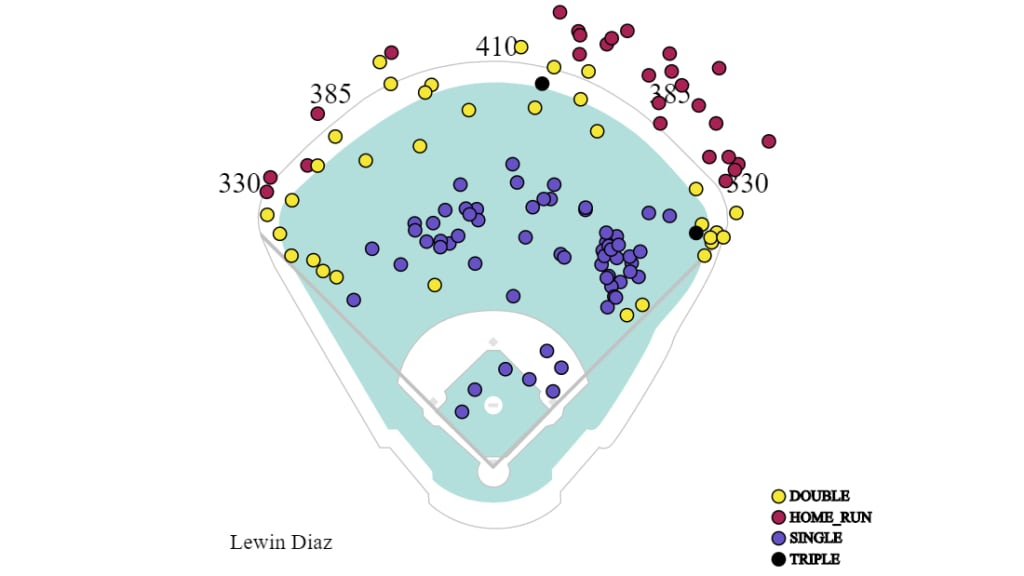
Mario Feliciano, C (Brewers No. 8): Yet another player who struggled to produce while battling injuries early in his career, Feliciano, whom Milwaukee selected with the No. 75 overall pick in the 2016 Draft, hit for both average and power in 2019, slashing .273/.324/.477 with a Carolina League-best 19 home runs and the circuit’s second-most RBIs (81). The 21-year-old catcher’s 56.2 percent FB+LD rate on BIP was a huge improvement over his 45 percent average from 2016-18, and he also made considerable gains against right-handed pitching, generating FB+LD contact 35.9 percent of the time after averaging 30 percent during his first three seasons.
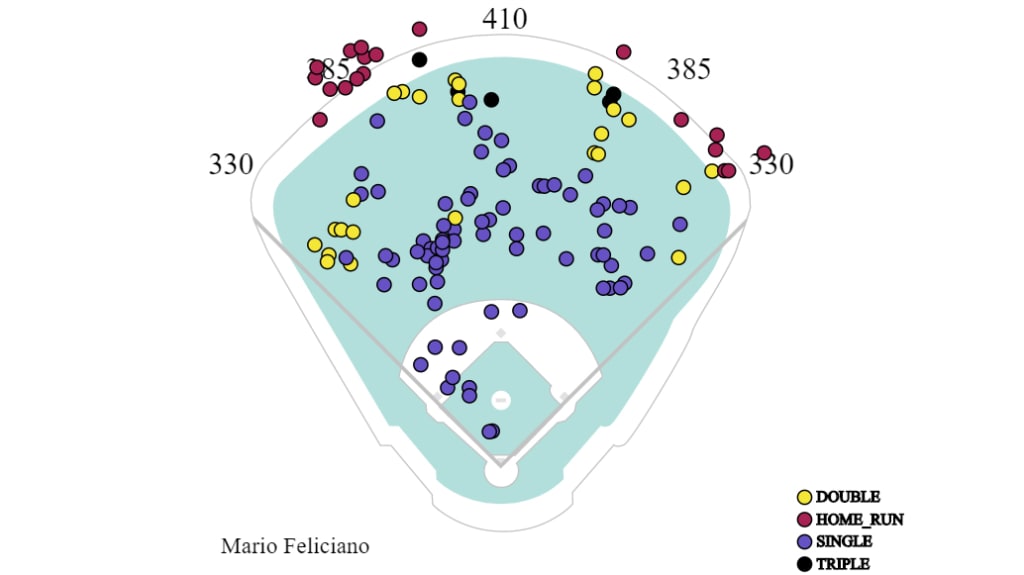
Gabriel Arias, SS (Padres No. 14): After an underwhelming first full season at Class A Fort Wayne (.240/.302/.352, 6 HR), Arias moved up to Class A Advanced Lake Elsinore in 2019 and slashed .302/.339/.470 with 17 homers in his age-19 season. While he surely benefitted from the California League’s hitter-friendly environments, the teenage shortstop made notable improvements with his approach and quality of contact. Notably, Arias fared better when trailing in the count compared to the previous year, boosting his FB+LD rate in such counts from 12.5 to 17.2 percent. Overall, Arias’ FB+LD rate on BIP climbed from 43.1 to 49.7 percent, while his ground-ball rate dropped from 53.7 to 44.4 percent.

Randy Arozarena, OF (Cardinals No. 10): Arozarena has long impressed evaluators with his athleticism and loud tools on the field, but it wasn’t until last season that the 24-year-old outfielder began to harness his talent. After batting .344/.431/.571 with 15 homers (career high) and 25 doubles between Double- and Triple-A, Arozarena made his big league debut on Aug. 13 and proceeded to hit .300 with one homer in 20 at-bats down the stretch. Arozarena’s FB+LD rate on BIP (44.9 percent) in the Minors was almost a five percent upgrade compared to his 2018 campaign -- the same goes for the reduction in his ground-ball rate -- and he demonstrated a more selectively aggressive approach while trimming his strikeout rate from 20.3 to 17.8 percent.
Jake Cronenworth, SS/RHP (Rays No. 17): Cronenworth, a seventh-round pick in the 2015 Draft, was making steady progress up the Minor League ladder before regressing in ’18 with a career-worst .253/.321/.345 batting line between Double-A and Triple-A. But after tacking on muscle during the offseason and adopting a more aggressive approach, the 25-year-old bounced back with a career-best performance in 2019, slashing .334/.429/.520 with 10 home runs in 88 Triple-A games. Cronenworth’s 47.8 percent FB+LD rate on BIP was a 5.8 percent improvement over his 2015-18 average, while his .449 isolated power on such contact was nearly double his 2015-18 average (.259).
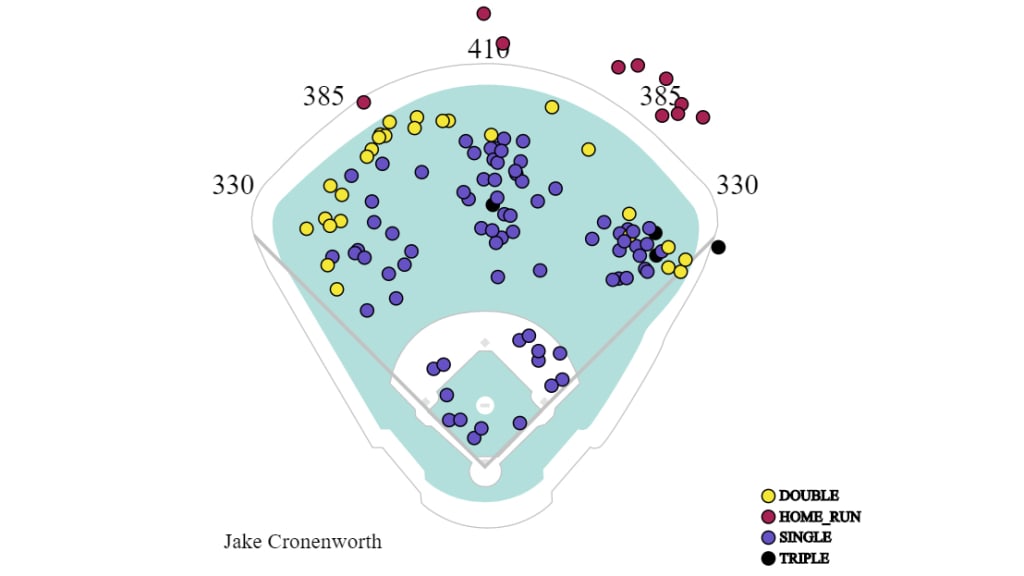
Jake Fraley, OF (Mariners No. 8): Acquired in the November 2018 trade that sent Mike Zunino and others to Tampa Bay, Fraley (the No. 77 pick in the 2016 Draft) reached the Major Leagues in his first Mariners season after raking at a .298/.365/.454 clip with 19 homers (51 XBH) across Double-A and Triple-A. While the natural loft in Fraley’s left-handed swing has always pointed toward future game power, he never got to it consistently during games until last season. Some of that may be tied to the fact that Fraley had issues staying healthy early in his career -- he hit seven homers in 151 games during his first three pro seasons -- but he also recorded a 56.8 percent FB+LD rate on batted balls in 2019 (MiLB only) that was well above his 2016-18 average of 50.3 percent, and experienced similar gains with his extra-base-hit rate.
